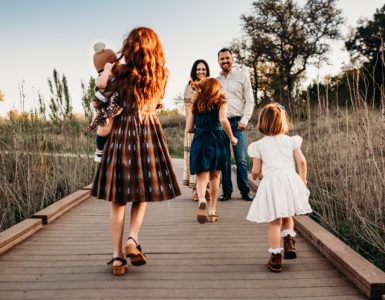“We look at adoption as a very sacred exchange. It is not done lightly on either side. I would dedicate my life to this child.” – Jamie Lee Curtis
Adoption is another form of love, whether that be in the form of choosing to have someone else raise your child or choosing to raise a child that does not share your blood. The exchange that takes place between families to unite them is an experience few will know.
One of the first questions people will ask about adoption is why the birth parent(s) chose to place a child for adoption. Oftentimes, this question is followed with a misleading and false answer that stems from something being wrong with the baby or the mother being a negative person. This is untrue in many cases.
For many pregnant women seeking to place a child for adoption, it simply is just not the right time for them to become a mother. Regardless of what is happening in her life at that time, she feels a baby would not benefit from being in her care right now.
It is with a loving heart that she has chosen to seek a better life for her child through adoption. This choice is not made lightly. The choice to adopt is also one that is not made lightly. On both sides, there are many aspects to consider and a variety of questions that loom.
If you’re looking for your sacred exchange in the form of adoption, here is some information to help you with the process of adopting a baby in Ohio.
1. What is Adoption?
When people think of adoption, oftentimes the image that comes to mind is in the form of adopting a baby from birth. Those first special moments holding a baby in your arms makes you feel complete.
Many choose to grow their family through adoption. A sweet baby entering the world and into their arms is an image worthy of all the emotions and joyful tears.
In technical terms, adoption is a legal proceeding that creates a parent/child relationship between persons not related by blood. The adopted child is entitled to all privileges belonging to a natural child of the adoptive parents, including the right to inherit.
There are instances when a couple or a single person cannot have children of their own or may choose not to biologically reproduce. Therefore, they seek other paths to their forever family, which includes adoption. Adoption gives families a chance to become whole.
2. Open Adoption
Many pregnant women search for the opportunity to have an open adoption. Open adoption allows for open communication between the birth parents and the adoptive parents. The families choose to remain in contact even after the adoption is finalized.
Open adoption allows the birth parent to watch their biological child grow up. They get to witness the life they chose for them. Research also shows that open adoptions are beneficial to the adopted child. The children are able to understand how they came to be adopted and the mystery of who they are does not exist. Open adoptions assist in closing that gap and creates stronger bonds between the child, the adoptive parents, and even the birth parents.
3. Closed Adoption
A closed adoption can be a choice made for the safety of a child. If a pregnant woman finds herself in a situation where she has to protect the identity of her child, closed adoption is often the best option.
In a closed adoption, the identity of the biological parents is kept secret from the child and the adoptive parents. Additionally, the biological parents are not privy to information about their biological child once the adoption has been finalized. This would mean that the biological parent would not know where the child would live and cannot request any updates about the child.
4. Semi-Open Adoption
The common ground between open and closed adoption is called a semi-open adoption. With a semi-open adoption, the biological parents can still receive updates regarding their biological child such as pictures. However, the name and location of the child’s whereabouts are not disclosed.
A semi-open adoption is a perfect compromise for birth parents to watch their child grow from afar while also providing some privacy to the adoptive parents.
5. Adopting a Baby in Ohio
If you are seeking information on adopting a baby in Ohio, there are many things to consider. Keep in mind that the adoption process varies from state to state. Therefore, it is important you are reviewing information specific to the state you wish to adopt within.
Below you will find answers to questions regarding the application to adopt, documents required, home study requirements, costs, and the length of time of the adoption process.
6. Begin the Process of Adopting a Baby in Ohio
An important part of the adoption process is the steps to becoming approved by the state of Ohio to adopt a child. In order to be approved, there are some rules and regulations specific to the state of Ohio that must be considered. The requirements for someone to adopt a child in Ohio are as follows:
- Must be 18 years old or older;
- At least one person in the family must communicate in English (both written and verbal);
- Provide contact information for others who can be used as references for the applicants;
- Household income must be enough to cover the basic needs of all members of the household and keep a roof over their head;
- Living spaces must have enough space to accommodate the child(ren) and their belongings;
- The applicant must be free of any physical, mental, or emotional conditions that would put a child in harm;
- Applicants must pass criminal background checks and abuse/neglect checks;
- The home must be free of any hazardous conditions and be able to pass a fire and safety inspection;
- Applicants must complete all training required by the adoption agency.
To begin the adoption application, prospective adoptive parents can retrieve an application from the Ohio Foster, Adoption and Kinship Care website.
7. Adopting a Baby in Ohio and Home Safety
Following the application for adoption, prospective adoptive parents should be aware of the home study that will take place. Before a child can be placed with a family, a home study must be completed.
A home study is an in-depth review of your home, documents, and other aspects of your life. During the home study, a walkthrough of your physical home will take place by an adoption professional to ensure it is a safe environment for a baby to live in. During the home walkthrough, interviews with the individuals living in the home will also take place.
While this may seem like an invasion of privacy, it is a necessary step in determining the adoptive parents’ capabilities for providing a safe, nurturing environment for a baby.
8. Home Study
In Ohio, there are two key areas that are thoroughly evaluated during the adoption process: documents submitted and the in-home visit. The following information about documents and in-home visits can be located on the American Adoptions website.
9. Documents
These documents will be required in order to proceed with the adoption application process in Ohio. Gathering these documents ahead of time won’t necessarily speed up the process. However, it will save the headache from having to quickly obtain these later on.
- Three references;
- Recent medical statements;
- Most recent financial statements;
- Background checks including abuse and neglect checks;
- Documentation of marriage and/or divorce (if applicable);
- Fire safety inspection;
- Water testing (if requested in the area).
The local state offices can assist you further in obtaining this information if there are any concerns or questions. Depending on your area, First Aid/CPR may also be required.
10. In-Home Visit
A complete walkthrough of all areas of the adoptive family’s home will be conducted. This part of the process might be the most nerve-wracking aspect, but it is essential for the future baby that could be living in an adoptive home. The following are Ohio’s minimum standards that need to be met and will be evaluated based on the adoption professional’s assessment of the following:
- Chemicals, medications, and other hazardous materials are out of reach of children;
- Heavy furniture is secured;
- Weapons and ammunition are stored in a safe;
- Window screens and locks are secured;
- Gates are on all stairways to prevent young children from falls;
- Electrical outlets are covered;
- Smoke and carbon dioxide detectors are in working condition;
- Signs or postings required indicating the adoption agency the family is paired with.
Following the in-home walkthrough, an interview will be conducted with all members of the household including children ages four years old and older. The interviews will assess aspects of the adoptive family’s:
- relationship as a couple, relationship with their family, and their goal of adoption.
- the couple’s own early childhood experiences and how those experiences influence their methods of parenting.
- adoptees, birth parent, and their role of race and culture in adoption.
- understanding of the overall process of adopting a baby in Ohio.
To prepare for the interview, it is best to be as open and honest as possible with the adoption professional. The questions most likely will not be shared ahead of time. Therefore, take some time to breathe, listen, and think of the questions before providing the answers. There is no wrong answer.
11. Cost of Adoption
Naturally, one of the biggest questions that crosses someone’s mind when considering adoption is how much it will cost. Are there costs for the birth parents? What can a prospective adoptive parent expect to pay? What exactly needs to be paid?
To place a child for adoption, there is no cost associated. In fact, there are assistance programs available for expecting mothers to help her with the expenses associated with her pregnancy.
When adopting in the state of Ohio, adoption expenses will vary depending on the type of adoption. Additionally, expenses will fluctuate depending on the type of agency you choose.
To adopt a baby in Ohio, typically prospective adoptive parents will go through a private agency to complete the process. With a private agency that specializes in infant adoption, you can expect the cost of adoption to range between $10,000 to $50,000.
There are adoption assistance programs available as well. To explore those options further, your adoption professional will be able to guide you. Additionally, the state of Ohio and the federal government allow families to claim an adoption tax credit for the year in which the adoption was legalized.
12. Length of Time to Finalize an Adoption in Ohio
Adopting a baby in Ohio is both exciting and unnerving. It is an experience that can be filled with anxiety at each step if the process is taking a while. However, what most adoptive parents don’t realize is that some adoptions can take up to a year to complete.
In other circumstances, a finalized adoption can take nearly two years. This could occur for a number of reasons such as an overflow of cases for adoption professionals, delays in receiving documents, or other unique circumstances.
It is important to know this beforehand so that you are better prepared. According to the state of Ohio’s website, it is their goal to have the home study completed within six months of the date the family completes their application.
13. Are You Ready to Begin Adopting a Baby in Ohio?
Finding your way to adopting a baby in Ohio can be a trying time, but it is also worth all the work. It is a life-changing experience to be able to welcome a child in your home. Adoption is a way to connect a family on various levels. The decision to place a child for adoption or to adopt a child into your home will make a positive impact in many ways.
For further information on adopting a baby in Ohio, research local adoption agencies and schedule a visit with an adoption professional. They will be able to answer your questions, provide information, and help you with the process of adopting a baby in Ohio.




